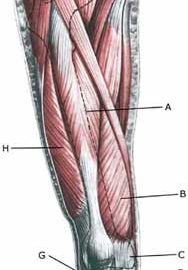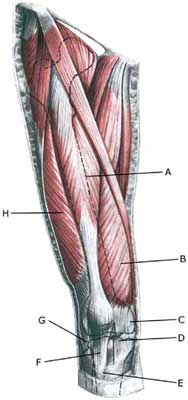|
|||
|
|||
| Cause: Repeated uniform loads on the knee cap (jumping, kicking) cause an over-load conditioned inflammation with a fragmentation of the bone at the knee cap ligaments fastening on the growth zone at the upper front part of the shin bone (tuberositas tibiae). The mechanism behind development of Osgood-Schlatter disease is the same in adults as for jumper’s knee. Osgood-Schlatter disease is one of the most common sports injuries in children and adolescents.
Symptoms: Slowly insetting tenderness at the upper, front part of the shin bone (tuberositas tibiae) during and after the sports activity. If the discomfort has a long duration, the bone fastening on the shin bone will become more prominent and can become so large that kneeling will be a problem. It is especially boys in the 10-16 age group that have the symptoms, and the condition is very common and can be seen in almost all boys’ football teams. The symptoms will diminish at around age 17 when the growth zone on the shinbone closes. Acute treatment: Click here. Examination: The diagnosis can usually be made with certainty under a normal medical examination, revealing localised tenderness on the knee cap fastening on the upper, front part of the shin bone. If there is any doubt surrounding the diagnosis an ultrasound scan can be performed to identify the changes (ultrasonic image), however, this is seldom necessary in uncomplicated cases (article). Treatment: The treatment comprises relief from the pain inducing activity (jumping, kicking). The injury can in some cases heal within a few weeks if the treatment is instigated quickly whereas a rehabilitation period of several months must be anticipated if the pain has been in evidence for some months. Emphasis is placed on stretching of the anterior thigh muscle. Ice treatment can be repeated every time tenderness is provoked in the knee cap ligament fastening during the rehabilitation period. If during the rehabilitation period pain is experienced when walking, medicinal treatment in the form of rheumatic medicine (NSAID) in gel form can be considered. Injection of corticosteroid should not be considered in the treatment (article). The sports activity can be cautiously resumed when the pain has diminished. Relapses will often occur, which should be followed as soon as possible with a period of relief. During the relief period it will usually be sufficient to abstain from the most stressful exercises (jumping), whilst many other training exercises can be performed without discomfort. In the majority of cases it will be therefore be possible to participate in at least a part of the sports activity (for example as goal-keeper). Bandage: Some patients have the opinion that the application of tape or bandage around the shin bone directly under the knee cap can relieve the discomfort (tape-description). Complications: In case of lack of progress it should be considered whether the diagnosis is correct or whether complications have arisen. Special consideration should be given to:
A tearing of the knee-cap tendon from the fastening on the shinbone has only been described in very rare cases. The torn part of the bone (on which the knee cap tendon is fastened) can be fixed to the shinbone again under surgical operation (article). |


